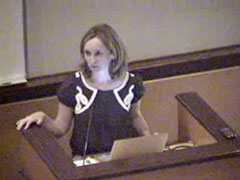Editor Pitches Publishing Tips for Researchers
By Jim Oldfield
The most intimidating part of writing a research paper for Dr. Rob Wallis, a postdoctoral fellow in the lab of Sunnybrook Research Institute senior scientist Dr. Philippe Poussier, is the blank page.
That nefarious obstacle was one reason Wallis attended Dr. Jocalyn Clark's June 22 talk at Sunnybrook, "Winning the Publications Game: An Insider's View of Medical Journals," sponsored by Sunnybrook's Centre for Health Services Sciences (CHSS).
Clark, a senior editor at the Public Library of Science journal PLoS Medicine, a former assistant editor at the British Medical Journal and an assistant professor of medicine (adjunct) at the University of Toronto, offered insights from the "dark side" of the publication process: how editors assess submissions, how to match research results with the right journal and—importantly for Wallis—a back-to-basics approach to writing.
The key part of the writing process, Clark stressed, is defining a message before starting. "Too many papers fail because what is being said isn't absolutely clear," said Clark. Many researchers, she finds, can't tell her in one line what their research is about. They often resort to repeating the paper's working title—a good sign they haven't thought the paper through.
The message, said Clark, is not the title or the research objective. It's a single sentence of about 12 words that contains a verb: "Mammography screening reduced deaths from breast cancer in Copenhagen," for example. Not, "Breast cancer mortality in Copenhagen after introduction of mammography screening: cohort study."
That focus, said Clark, limits tangential forays. It gives rise to a structure for the paper—introduction, method, results, discussion—that hangs together around the message, and answers the "four W's:" why you started the research, what you did, what you found and why it matters.
Wallis, though an experienced postdoc who's authored several papers, never got such training. "I was pleasantly surprised and found it very helpful," he said.
Beyond pragmatic writing tips, Clark offered a blunt take on editorial decision-making and the peer-review process.
The idea that either is objective is "completely ridiculous," Clark said. "Like all scientific activity, the editorial process is a social process, because it involves a number of individuals who bring their own biases, expertise and ideas on how journals should look."
Hence the importance of "market researching" journals before submitting a manuscript, Clark said. Journals have different audiences and aims—specialized versus general being a critical distinction—and will take different editorial angles on a given subject. Knowing those tendencies, said Clark, and picking up on "threads," current topics of interest to a journal, can be very effective in getting a paper accepted.
Clark also believes it's important to avoid "highballing," or targeting top-level journals for every paper; it wastes time and dents confidence. Instead, she suggested, build a steady stream of solid publications in good journals.
Taken together, Clark's recommendations form what she called an "evidence-based approach" to writing. "I really think once you've done all that preplanning, the paper will write itself," she said.
Clark also offered a tip for those smarting from a rejected manuscript: appeal, especially if you feel the reviewers missed something important. Thoughtful, well-reasoned appeals do work—about 20% of the time, in her experience.
Katie Dainty, CHSS program manager and the host of Clark's talk, was pleased with attendance and thought the event useful. "Given the emphasis today on knowledge translation, researchers need to write clearly and communicate with multiple audiences, whether they're looking at cells, patients or health services," said Dainty.
"The more information we can share about successful publication and how researchers can 'sell' the terrific work they're doing here, the better it is for Sunnybrook."
PDF / View full media release »





